LINFOX Logistics Supply Chain: Analysis, Problems & Solutions Report
VerifiedAdded on 2023/04/23
|12
|2909
|195
Report
AI Summary
This report provides an in-depth analysis of LINFOX Logistics' supply chain operations, highlighting the relevance of supply chain management to the company's overall performance. It examines the current supply chain, identifying problems within the logistics network, such as asset prioritization, inland depot conflicts, and limited storage. The report then proposes strategies to address these issues, including reverse logistics, collaboration within the industry, intermodal transportation, and restricted capacity management. The analysis utilizes both quantitative measures like Warehouse Management Systems (WMS) and inventory turnover rates, as well as qualitative measures such as MS ISO 9001:2000 certification, to assess the supply chain's effectiveness and compliance with industry standards and customer requirements.

Running head: LOGISTICS
LOGISTICS
Name of student
Name of university
Author’s note:
LOGISTICS
Name of student
Name of university
Author’s note:
Paraphrase This Document
Need a fresh take? Get an instant paraphrase of this document with our AI Paraphraser
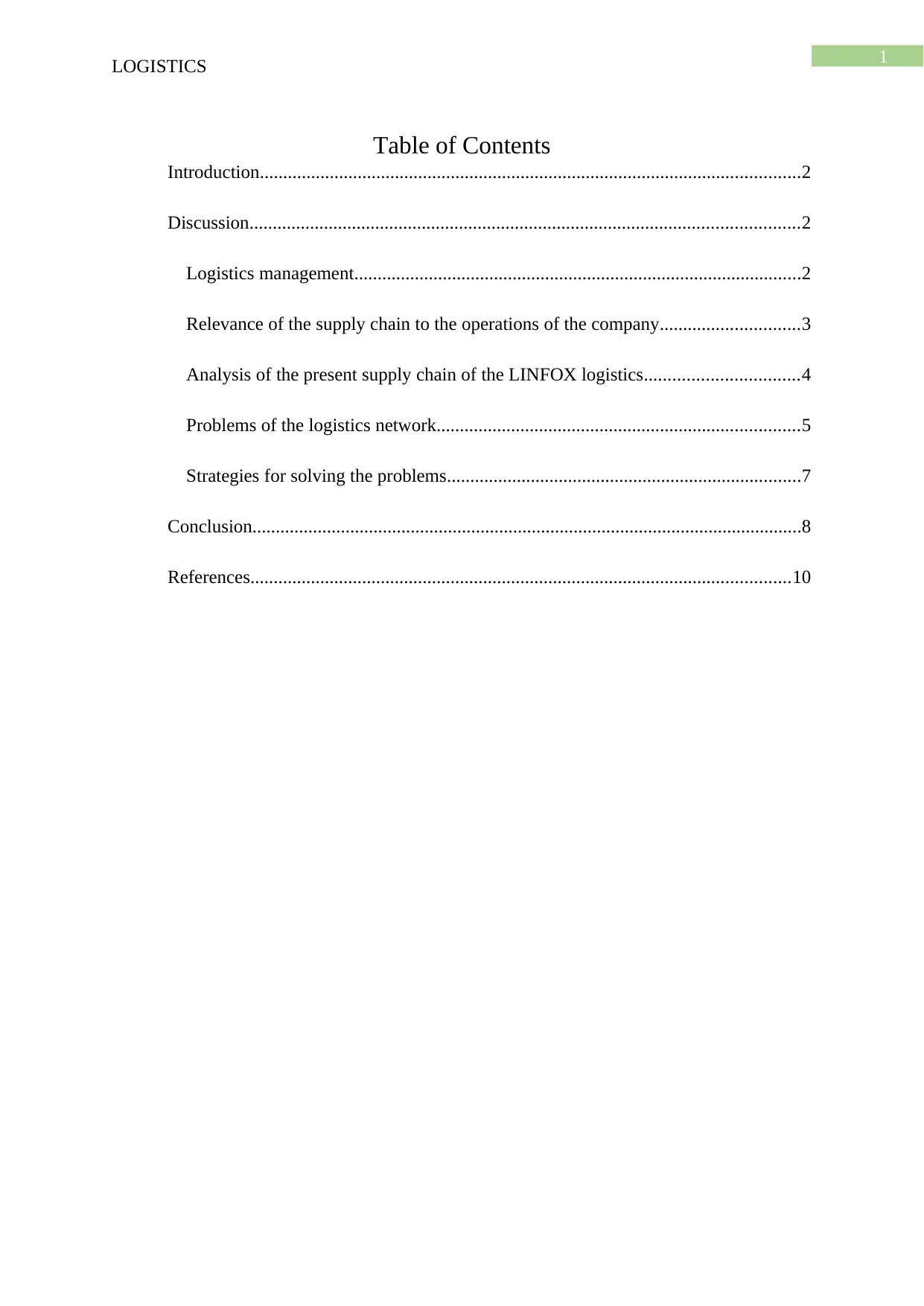
1
LOGISTICS
Table of Contents
Introduction....................................................................................................................2
Discussion......................................................................................................................2
Logistics management................................................................................................2
Relevance of the supply chain to the operations of the company..............................3
Analysis of the present supply chain of the LINFOX logistics.................................4
Problems of the logistics network..............................................................................5
Strategies for solving the problems............................................................................7
Conclusion......................................................................................................................8
References....................................................................................................................10
LOGISTICS
Table of Contents
Introduction....................................................................................................................2
Discussion......................................................................................................................2
Logistics management................................................................................................2
Relevance of the supply chain to the operations of the company..............................3
Analysis of the present supply chain of the LINFOX logistics.................................4
Problems of the logistics network..............................................................................5
Strategies for solving the problems............................................................................7
Conclusion......................................................................................................................8
References....................................................................................................................10

2
LOGISTICS
Introduction
This report aims to discuss the topic of logistics in Intermodal company in Australia.
The report focusses on the significance of the supply chain management, particularly the
intention of this study is in gaining knowledge about logistics of the company and understand
the issues in logistics and provide with appropriate solutions. This study can be used for
gaining insight regarding the business needs and the effective logistics management in the
companies and how to deal with them.
The aspect of supply chain management and logistics are both combined in the SCM.
SCM is considered as the combination of the the inventory location, production, and logistics
in the supply chain (Priest, 2014). The strategic and the systematic collaboration of the
purposes accomplishes the most suitable coordination of the response and efficiency in
fulfilling the demands of the customers.
Discussion
Logistics management
Logistics is the sector of supply chain, which controls, conducts the planning and then
deploys the movement of inventory, which is the goods and services, from them origin point
of the production to the ultimate customer. In any corporate markets, the scope of the
logistics involves the shipping, transportation, import and the warehousing and the export
operations. Additionally, the logistics also monitors the inventory management, planning of
the production, and the customer services (Constant and Han, 2013). The significance of the
performance in supply chain is significant. Any effective performance system of the supply
chain could offer the base for understanding the supply chain system of the company. This
influences the behaviour of the supply chain and importantly, this displays the information
related to the consequences of the supply chain to the stakeholders and the company.
LOGISTICS
Introduction
This report aims to discuss the topic of logistics in Intermodal company in Australia.
The report focusses on the significance of the supply chain management, particularly the
intention of this study is in gaining knowledge about logistics of the company and understand
the issues in logistics and provide with appropriate solutions. This study can be used for
gaining insight regarding the business needs and the effective logistics management in the
companies and how to deal with them.
The aspect of supply chain management and logistics are both combined in the SCM.
SCM is considered as the combination of the the inventory location, production, and logistics
in the supply chain (Priest, 2014). The strategic and the systematic collaboration of the
purposes accomplishes the most suitable coordination of the response and efficiency in
fulfilling the demands of the customers.
Discussion
Logistics management
Logistics is the sector of supply chain, which controls, conducts the planning and then
deploys the movement of inventory, which is the goods and services, from them origin point
of the production to the ultimate customer. In any corporate markets, the scope of the
logistics involves the shipping, transportation, import and the warehousing and the export
operations. Additionally, the logistics also monitors the inventory management, planning of
the production, and the customer services (Constant and Han, 2013). The significance of the
performance in supply chain is significant. Any effective performance system of the supply
chain could offer the base for understanding the supply chain system of the company. This
influences the behaviour of the supply chain and importantly, this displays the information
related to the consequences of the supply chain to the stakeholders and the company.
⊘ This is a preview!⊘
Do you want full access?
Subscribe today to unlock all pages.

Trusted by 1+ million students worldwide
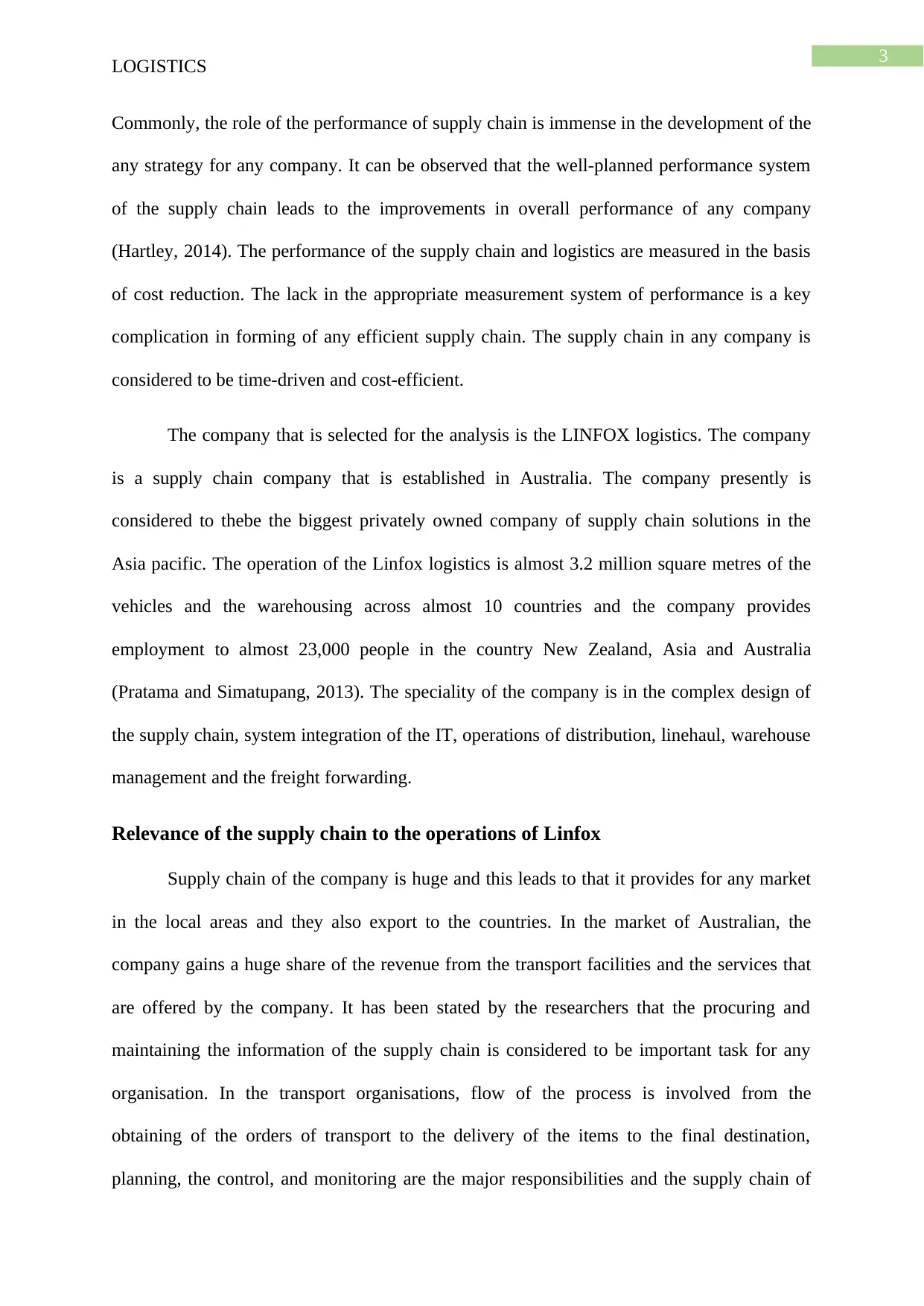
3
LOGISTICS
Commonly, the role of the performance of supply chain is immense in the development of the
any strategy for any company. It can be observed that the well-planned performance system
of the supply chain leads to the improvements in overall performance of any company
(Hartley, 2014). The performance of the supply chain and logistics are measured in the basis
of cost reduction. The lack in the appropriate measurement system of performance is a key
complication in forming of any efficient supply chain. The supply chain in any company is
considered to be time-driven and cost-efficient.
The company that is selected for the analysis is the LINFOX logistics. The company
is a supply chain company that is established in Australia. The company presently is
considered to thebe the biggest privately owned company of supply chain solutions in the
Asia pacific. The operation of the Linfox logistics is almost 3.2 million square metres of the
vehicles and the warehousing across almost 10 countries and the company provides
employment to almost 23,000 people in the country New Zealand, Asia and Australia
(Pratama and Simatupang, 2013). The speciality of the company is in the complex design of
the supply chain, system integration of the IT, operations of distribution, linehaul, warehouse
management and the freight forwarding.
Relevance of the supply chain to the operations of Linfox
Supply chain of the company is huge and this leads to that it provides for any market
in the local areas and they also export to the countries. In the market of Australian, the
company gains a huge share of the revenue from the transport facilities and the services that
are offered by the company. It has been stated by the researchers that the procuring and
maintaining the information of the supply chain is considered to be important task for any
organisation. In the transport organisations, flow of the process is involved from the
obtaining of the orders of transport to the delivery of the items to the final destination,
planning, the control, and monitoring are the major responsibilities and the supply chain of
LOGISTICS
Commonly, the role of the performance of supply chain is immense in the development of the
any strategy for any company. It can be observed that the well-planned performance system
of the supply chain leads to the improvements in overall performance of any company
(Hartley, 2014). The performance of the supply chain and logistics are measured in the basis
of cost reduction. The lack in the appropriate measurement system of performance is a key
complication in forming of any efficient supply chain. The supply chain in any company is
considered to be time-driven and cost-efficient.
The company that is selected for the analysis is the LINFOX logistics. The company
is a supply chain company that is established in Australia. The company presently is
considered to thebe the biggest privately owned company of supply chain solutions in the
Asia pacific. The operation of the Linfox logistics is almost 3.2 million square metres of the
vehicles and the warehousing across almost 10 countries and the company provides
employment to almost 23,000 people in the country New Zealand, Asia and Australia
(Pratama and Simatupang, 2013). The speciality of the company is in the complex design of
the supply chain, system integration of the IT, operations of distribution, linehaul, warehouse
management and the freight forwarding.
Relevance of the supply chain to the operations of Linfox
Supply chain of the company is huge and this leads to that it provides for any market
in the local areas and they also export to the countries. In the market of Australian, the
company gains a huge share of the revenue from the transport facilities and the services that
are offered by the company. It has been stated by the researchers that the procuring and
maintaining the information of the supply chain is considered to be important task for any
organisation. In the transport organisations, flow of the process is involved from the
obtaining of the orders of transport to the delivery of the items to the final destination,
planning, the control, and monitoring are the major responsibilities and the supply chain of
Paraphrase This Document
Need a fresh take? Get an instant paraphrase of this document with our AI Paraphraser
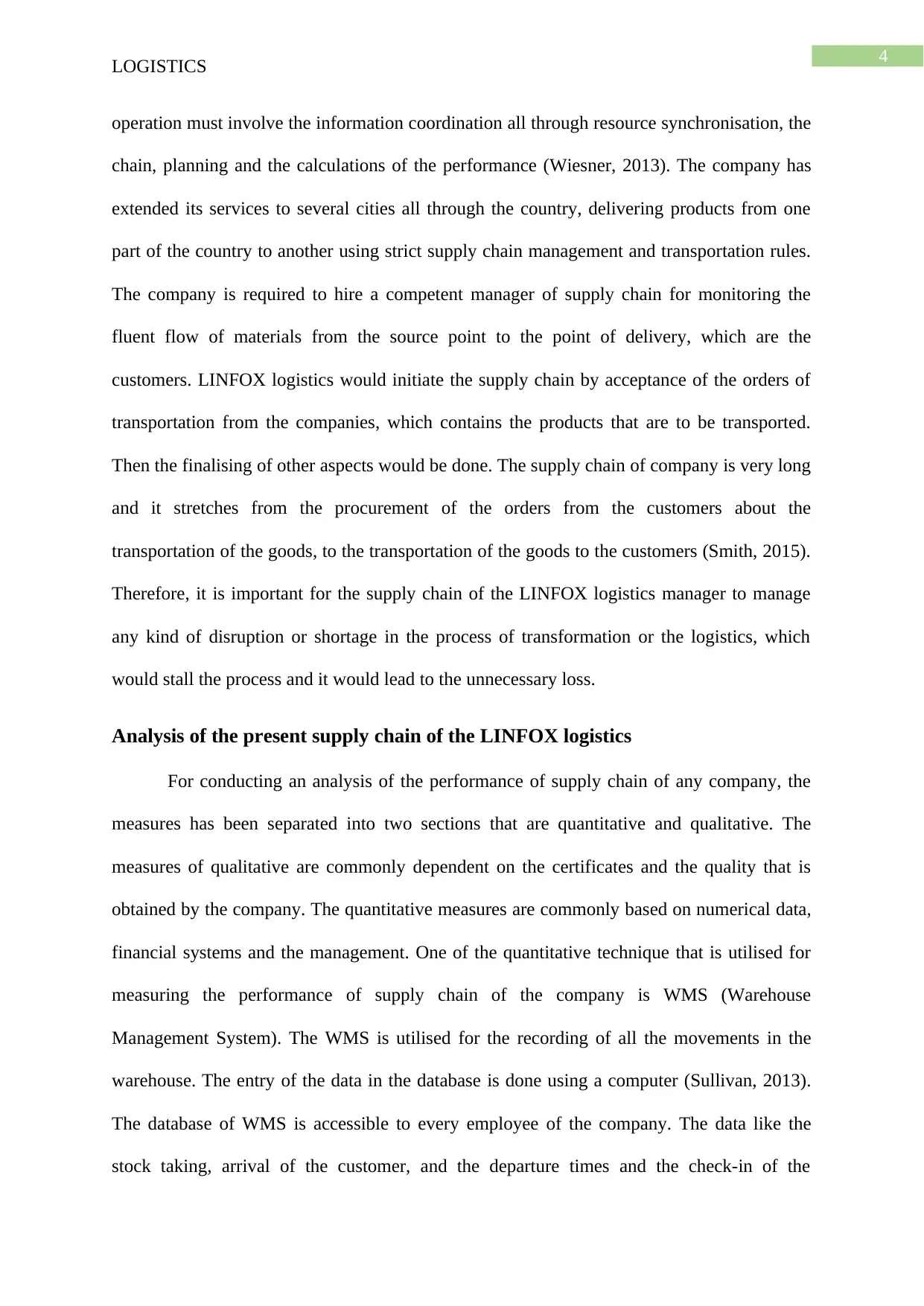
4
LOGISTICS
operation must involve the information coordination all through resource synchronisation, the
chain, planning and the calculations of the performance (Wiesner, 2013). The company has
extended its services to several cities all through the country, delivering products from one
part of the country to another using strict supply chain management and transportation rules.
The company is required to hire a competent manager of supply chain for monitoring the
fluent flow of materials from the source point to the point of delivery, which are the
customers. LINFOX logistics would initiate the supply chain by acceptance of the orders of
transportation from the companies, which contains the products that are to be transported.
Then the finalising of other aspects would be done. The supply chain of company is very long
and it stretches from the procurement of the orders from the customers about the
transportation of the goods, to the transportation of the goods to the customers (Smith, 2015).
Therefore, it is important for the supply chain of the LINFOX logistics manager to manage
any kind of disruption or shortage in the process of transformation or the logistics, which
would stall the process and it would lead to the unnecessary loss.
Analysis of the present supply chain of the LINFOX logistics
For conducting an analysis of the performance of supply chain of any company, the
measures has been separated into two sections that are quantitative and qualitative. The
measures of qualitative are commonly dependent on the certificates and the quality that is
obtained by the company. The quantitative measures are commonly based on numerical data,
financial systems and the management. One of the quantitative technique that is utilised for
measuring the performance of supply chain of the company is WMS (Warehouse
Management System). The WMS is utilised for the recording of all the movements in the
warehouse. The entry of the data in the database is done using a computer (Sullivan, 2013).
The database of WMS is accessible to every employee of the company. The data like the
stock taking, arrival of the customer, and the departure times and the check-in of the
LOGISTICS
operation must involve the information coordination all through resource synchronisation, the
chain, planning and the calculations of the performance (Wiesner, 2013). The company has
extended its services to several cities all through the country, delivering products from one
part of the country to another using strict supply chain management and transportation rules.
The company is required to hire a competent manager of supply chain for monitoring the
fluent flow of materials from the source point to the point of delivery, which are the
customers. LINFOX logistics would initiate the supply chain by acceptance of the orders of
transportation from the companies, which contains the products that are to be transported.
Then the finalising of other aspects would be done. The supply chain of company is very long
and it stretches from the procurement of the orders from the customers about the
transportation of the goods, to the transportation of the goods to the customers (Smith, 2015).
Therefore, it is important for the supply chain of the LINFOX logistics manager to manage
any kind of disruption or shortage in the process of transformation or the logistics, which
would stall the process and it would lead to the unnecessary loss.
Analysis of the present supply chain of the LINFOX logistics
For conducting an analysis of the performance of supply chain of any company, the
measures has been separated into two sections that are quantitative and qualitative. The
measures of qualitative are commonly dependent on the certificates and the quality that is
obtained by the company. The quantitative measures are commonly based on numerical data,
financial systems and the management. One of the quantitative technique that is utilised for
measuring the performance of supply chain of the company is WMS (Warehouse
Management System). The WMS is utilised for the recording of all the movements in the
warehouse. The entry of the data in the database is done using a computer (Sullivan, 2013).
The database of WMS is accessible to every employee of the company. The data like the
stock taking, arrival of the customer, and the departure times and the check-in of the
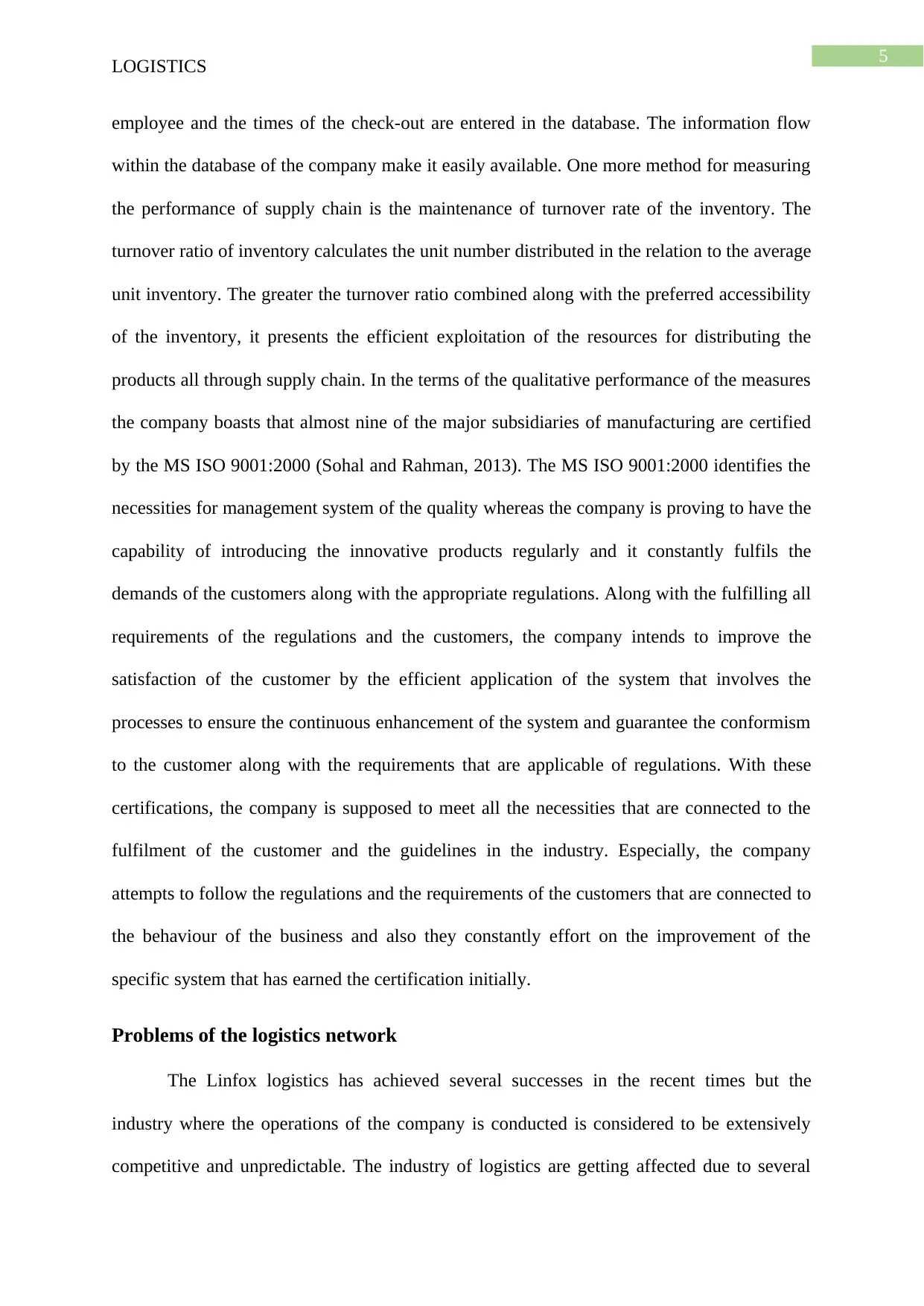
5
LOGISTICS
employee and the times of the check-out are entered in the database. The information flow
within the database of the company make it easily available. One more method for measuring
the performance of supply chain is the maintenance of turnover rate of the inventory. The
turnover ratio of inventory calculates the unit number distributed in the relation to the average
unit inventory. The greater the turnover ratio combined along with the preferred accessibility
of the inventory, it presents the efficient exploitation of the resources for distributing the
products all through supply chain. In the terms of the qualitative performance of the measures
the company boasts that almost nine of the major subsidiaries of manufacturing are certified
by the MS ISO 9001:2000 (Sohal and Rahman, 2013). The MS ISO 9001:2000 identifies the
necessities for management system of the quality whereas the company is proving to have the
capability of introducing the innovative products regularly and it constantly fulfils the
demands of the customers along with the appropriate regulations. Along with the fulfilling all
requirements of the regulations and the customers, the company intends to improve the
satisfaction of the customer by the efficient application of the system that involves the
processes to ensure the continuous enhancement of the system and guarantee the conformism
to the customer along with the requirements that are applicable of regulations. With these
certifications, the company is supposed to meet all the necessities that are connected to the
fulfilment of the customer and the guidelines in the industry. Especially, the company
attempts to follow the regulations and the requirements of the customers that are connected to
the behaviour of the business and also they constantly effort on the improvement of the
specific system that has earned the certification initially.
Problems of the logistics network
The Linfox logistics has achieved several successes in the recent times but the
industry where the operations of the company is conducted is considered to be extensively
competitive and unpredictable. The industry of logistics are getting affected due to several
LOGISTICS
employee and the times of the check-out are entered in the database. The information flow
within the database of the company make it easily available. One more method for measuring
the performance of supply chain is the maintenance of turnover rate of the inventory. The
turnover ratio of inventory calculates the unit number distributed in the relation to the average
unit inventory. The greater the turnover ratio combined along with the preferred accessibility
of the inventory, it presents the efficient exploitation of the resources for distributing the
products all through supply chain. In the terms of the qualitative performance of the measures
the company boasts that almost nine of the major subsidiaries of manufacturing are certified
by the MS ISO 9001:2000 (Sohal and Rahman, 2013). The MS ISO 9001:2000 identifies the
necessities for management system of the quality whereas the company is proving to have the
capability of introducing the innovative products regularly and it constantly fulfils the
demands of the customers along with the appropriate regulations. Along with the fulfilling all
requirements of the regulations and the customers, the company intends to improve the
satisfaction of the customer by the efficient application of the system that involves the
processes to ensure the continuous enhancement of the system and guarantee the conformism
to the customer along with the requirements that are applicable of regulations. With these
certifications, the company is supposed to meet all the necessities that are connected to the
fulfilment of the customer and the guidelines in the industry. Especially, the company
attempts to follow the regulations and the requirements of the customers that are connected to
the behaviour of the business and also they constantly effort on the improvement of the
specific system that has earned the certification initially.
Problems of the logistics network
The Linfox logistics has achieved several successes in the recent times but the
industry where the operations of the company is conducted is considered to be extensively
competitive and unpredictable. The industry of logistics are getting affected due to several
⊘ This is a preview!⊘
Do you want full access?
Subscribe today to unlock all pages.

Trusted by 1+ million students worldwide

6
LOGISTICS
factors in and outside any organisation that risks the appropriate functioning of system
(Gilmour, Driva and Hunt, 2015). The present NSW logistics network are also facing some
difficult issues like the national strategies and policies, the issues due to the regulations,
development policies and the strategies of the state transport, planning of the regional
transport, and regional planning the investment on the infrastructure.
Asset prioritisation and recycling
The Port Botany is considered as the second major port of container in Australia. The
NSW ports consortium holds the lease of this port. This is an initiative of the asset recycling
that is undertaken by the government of Australia.
Inland conflict of depot
There is a 60-hectare area that is unused left in the industrial are that is connected by
the rail line to the Port Botany. The development of this area was being planned when this
created a conflict among the local government (Merkert and Hensher, 2014). The limited
storage of container and the limited terminal space. The terminals are the intermodal limit in
the logistics network.
Strategy of logistics management
The major intention of the management of logistics is the creation of any plan for
coordinating the required steps for gaining the best service at the minimal cost (Smith and
Lawrence, 2014). Logistics includes the overall process transportation that starts from the
picking of the product from the point of origin until the drop at destination point. Due to the
constant evolvement and the modification in the supply chains in the present world, it creates
the requirement of the designing of the strategies of the logistics management on the basis of
the various customers, various locations and several lines of product (Joyce, 2015). As the
LOGISTICS
factors in and outside any organisation that risks the appropriate functioning of system
(Gilmour, Driva and Hunt, 2015). The present NSW logistics network are also facing some
difficult issues like the national strategies and policies, the issues due to the regulations,
development policies and the strategies of the state transport, planning of the regional
transport, and regional planning the investment on the infrastructure.
Asset prioritisation and recycling
The Port Botany is considered as the second major port of container in Australia. The
NSW ports consortium holds the lease of this port. This is an initiative of the asset recycling
that is undertaken by the government of Australia.
Inland conflict of depot
There is a 60-hectare area that is unused left in the industrial are that is connected by
the rail line to the Port Botany. The development of this area was being planned when this
created a conflict among the local government (Merkert and Hensher, 2014). The limited
storage of container and the limited terminal space. The terminals are the intermodal limit in
the logistics network.
Strategy of logistics management
The major intention of the management of logistics is the creation of any plan for
coordinating the required steps for gaining the best service at the minimal cost (Smith and
Lawrence, 2014). Logistics includes the overall process transportation that starts from the
picking of the product from the point of origin until the drop at destination point. Due to the
constant evolvement and the modification in the supply chains in the present world, it creates
the requirement of the designing of the strategies of the logistics management on the basis of
the various customers, various locations and several lines of product (Joyce, 2015). As the
Paraphrase This Document
Need a fresh take? Get an instant paraphrase of this document with our AI Paraphraser

7
LOGISTICS
company is facing these issues presently, there are several strategies that are implemented by
the management for overcoming issues and several other recommendations are also provided.
Multimodal transport access
The transfer of port activities has been done from the Port Jackson to the Port Botany
that has led to the alteration of the split of modal of the containers, which are transported
from the port (Trinh, 2018). The designing of the Port Botany was appropriate for conducting
the transportation using the trucks. The companies of the export/import had clash on this
subject that the container trucks must not disrupt the environmental rules and not problems in
the environment must rise due to this transportation.
Strategies for solving the problems
Reverse logistics
This is the mechanism for dealing with the products that might not be usable or where
there is not requirement. The operation of this procedure is done for the reuse of the material
or the movement of the products from destination point to the capture value. The four
sections of the reverse logistics are the substitution, recycle, reduction and the reuse.
Collaboration with the logistics
While the decision of the operational strategies for conducting, companies of the
similar and the connected industry must be collaborated and significant decision must be
undertaken. If any company makes the decision for the central decision, this might
unfavourably affect the functioning of any other company. For this reason, the logistics
alliance must be formed for tackling this issue
Intermodal transportation
LOGISTICS
company is facing these issues presently, there are several strategies that are implemented by
the management for overcoming issues and several other recommendations are also provided.
Multimodal transport access
The transfer of port activities has been done from the Port Jackson to the Port Botany
that has led to the alteration of the split of modal of the containers, which are transported
from the port (Trinh, 2018). The designing of the Port Botany was appropriate for conducting
the transportation using the trucks. The companies of the export/import had clash on this
subject that the container trucks must not disrupt the environmental rules and not problems in
the environment must rise due to this transportation.
Strategies for solving the problems
Reverse logistics
This is the mechanism for dealing with the products that might not be usable or where
there is not requirement. The operation of this procedure is done for the reuse of the material
or the movement of the products from destination point to the capture value. The four
sections of the reverse logistics are the substitution, recycle, reduction and the reuse.
Collaboration with the logistics
While the decision of the operational strategies for conducting, companies of the
similar and the connected industry must be collaborated and significant decision must be
undertaken. If any company makes the decision for the central decision, this might
unfavourably affect the functioning of any other company. For this reason, the logistics
alliance must be formed for tackling this issue
Intermodal transportation

8
LOGISTICS
The transportation that is using several modes in the beneficial and common process
that the Linfox Logistics is already exploiting. The method offers the quick delivery of the
freight with significantly lower chances of the damage or any kind of loss (Lawrence, 2013).
Moreover, it can be utilised in the remote or the regional area for making the transportation
fruitful and convenient.
Restricted capacity
In the situations when there are not enough machines, the drivers, trucks or the
warehouse space, the phenomenon of the restricted capacity must be used. Using this strategy
the backhauls must allow the empty vehicles to be used (Sermcheep and Chirathivat, 2015).
Conclusion
Therefore, it can be concluded that the company Linfox logistics could apply the
measures for solving the problems by using the theories of logistics management even though
several of these theories are already implemented in the organisation. The aspect of supply
chain management and logistics are both combined in the SCM. SCM is considered as the
combination of the the inventory location, production, and logistics in the supply chain.
Logistics is the sector of supply chain, which controls, conducts the planning and then
deploys the movement of inventory, which is the goods and services, from them origin point
of the production to the ultimate customer. The company that is selected for the analysis is
the LINFOX logistics. The company is a supply chain company that is established in
Australia. The company presently is considered to thebe the biggest privately owned
company of supply chain solutions in the Asia pacific. The supply chain of the company is
huge and this leads to that supplies for any market that is situated locally and it also conducts
exporting to the countries. The company makes a huge share of the revenue in the Australian
market from the transport facilities and the services that are offered by the company.
LOGISTICS
The transportation that is using several modes in the beneficial and common process
that the Linfox Logistics is already exploiting. The method offers the quick delivery of the
freight with significantly lower chances of the damage or any kind of loss (Lawrence, 2013).
Moreover, it can be utilised in the remote or the regional area for making the transportation
fruitful and convenient.
Restricted capacity
In the situations when there are not enough machines, the drivers, trucks or the
warehouse space, the phenomenon of the restricted capacity must be used. Using this strategy
the backhauls must allow the empty vehicles to be used (Sermcheep and Chirathivat, 2015).
Conclusion
Therefore, it can be concluded that the company Linfox logistics could apply the
measures for solving the problems by using the theories of logistics management even though
several of these theories are already implemented in the organisation. The aspect of supply
chain management and logistics are both combined in the SCM. SCM is considered as the
combination of the the inventory location, production, and logistics in the supply chain.
Logistics is the sector of supply chain, which controls, conducts the planning and then
deploys the movement of inventory, which is the goods and services, from them origin point
of the production to the ultimate customer. The company that is selected for the analysis is
the LINFOX logistics. The company is a supply chain company that is established in
Australia. The company presently is considered to thebe the biggest privately owned
company of supply chain solutions in the Asia pacific. The supply chain of the company is
huge and this leads to that supplies for any market that is situated locally and it also conducts
exporting to the countries. The company makes a huge share of the revenue in the Australian
market from the transport facilities and the services that are offered by the company.
⊘ This is a preview!⊘
Do you want full access?
Subscribe today to unlock all pages.

Trusted by 1+ million students worldwide

9
LOGISTICS
LOGISTICS
Paraphrase This Document
Need a fresh take? Get an instant paraphrase of this document with our AI Paraphraser
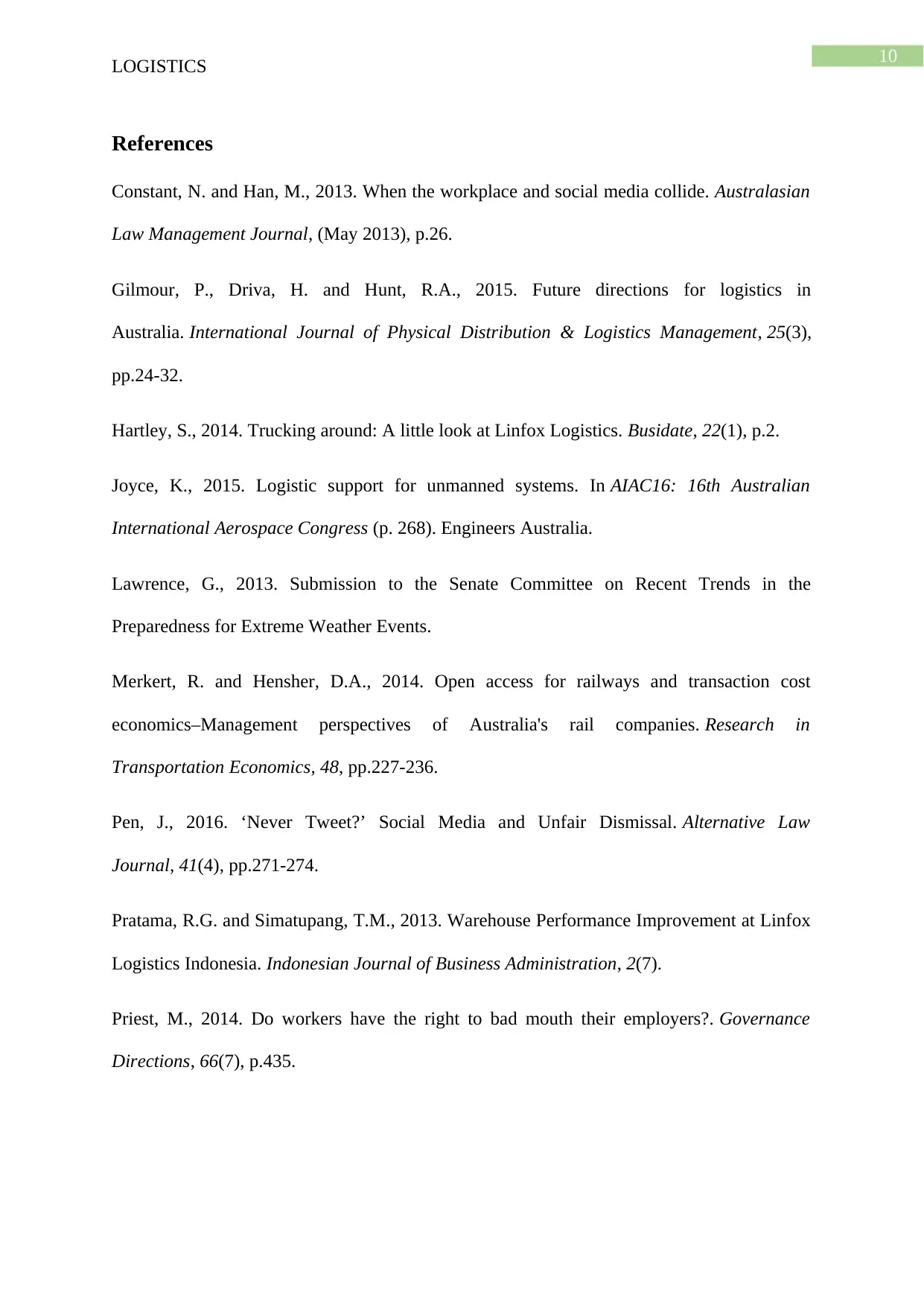
10
LOGISTICS
References
Constant, N. and Han, M., 2013. When the workplace and social media collide. Australasian
Law Management Journal, (May 2013), p.26.
Gilmour, P., Driva, H. and Hunt, R.A., 2015. Future directions for logistics in
Australia. International Journal of Physical Distribution & Logistics Management, 25(3),
pp.24-32.
Hartley, S., 2014. Trucking around: A little look at Linfox Logistics. Busidate, 22(1), p.2.
Joyce, K., 2015. Logistic support for unmanned systems. In AIAC16: 16th Australian
International Aerospace Congress (p. 268). Engineers Australia.
Lawrence, G., 2013. Submission to the Senate Committee on Recent Trends in the
Preparedness for Extreme Weather Events.
Merkert, R. and Hensher, D.A., 2014. Open access for railways and transaction cost
economics–Management perspectives of Australia's rail companies. Research in
Transportation Economics, 48, pp.227-236.
Pen, J., 2016. ‘Never Tweet?’ Social Media and Unfair Dismissal. Alternative Law
Journal, 41(4), pp.271-274.
Pratama, R.G. and Simatupang, T.M., 2013. Warehouse Performance Improvement at Linfox
Logistics Indonesia. Indonesian Journal of Business Administration, 2(7).
Priest, M., 2014. Do workers have the right to bad mouth their employers?. Governance
Directions, 66(7), p.435.
LOGISTICS
References
Constant, N. and Han, M., 2013. When the workplace and social media collide. Australasian
Law Management Journal, (May 2013), p.26.
Gilmour, P., Driva, H. and Hunt, R.A., 2015. Future directions for logistics in
Australia. International Journal of Physical Distribution & Logistics Management, 25(3),
pp.24-32.
Hartley, S., 2014. Trucking around: A little look at Linfox Logistics. Busidate, 22(1), p.2.
Joyce, K., 2015. Logistic support for unmanned systems. In AIAC16: 16th Australian
International Aerospace Congress (p. 268). Engineers Australia.
Lawrence, G., 2013. Submission to the Senate Committee on Recent Trends in the
Preparedness for Extreme Weather Events.
Merkert, R. and Hensher, D.A., 2014. Open access for railways and transaction cost
economics–Management perspectives of Australia's rail companies. Research in
Transportation Economics, 48, pp.227-236.
Pen, J., 2016. ‘Never Tweet?’ Social Media and Unfair Dismissal. Alternative Law
Journal, 41(4), pp.271-274.
Pratama, R.G. and Simatupang, T.M., 2013. Warehouse Performance Improvement at Linfox
Logistics Indonesia. Indonesian Journal of Business Administration, 2(7).
Priest, M., 2014. Do workers have the right to bad mouth their employers?. Governance
Directions, 66(7), p.435.
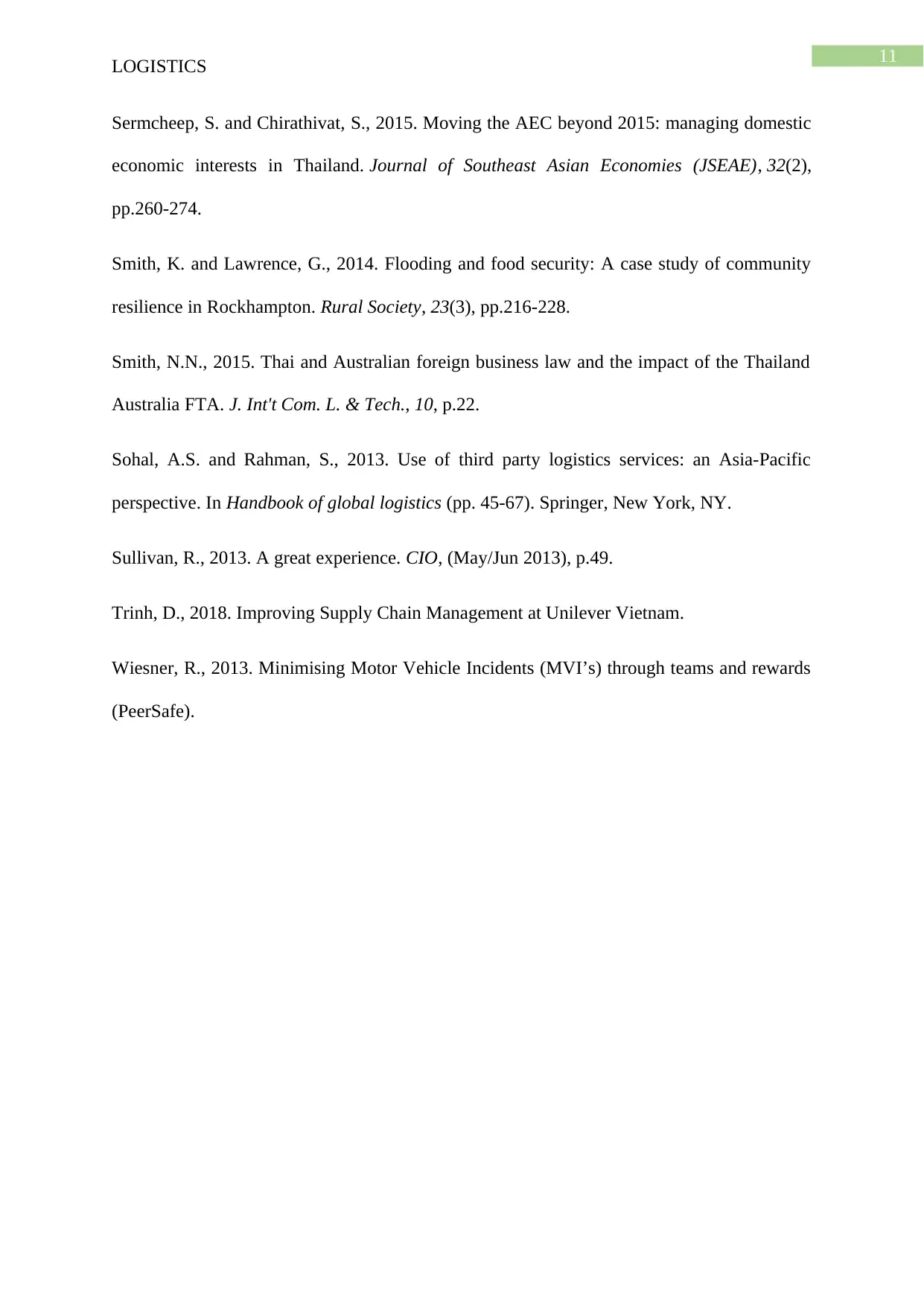
11
LOGISTICS
Sermcheep, S. and Chirathivat, S., 2015. Moving the AEC beyond 2015: managing domestic
economic interests in Thailand. Journal of Southeast Asian Economies (JSEAE), 32(2),
pp.260-274.
Smith, K. and Lawrence, G., 2014. Flooding and food security: A case study of community
resilience in Rockhampton. Rural Society, 23(3), pp.216-228.
Smith, N.N., 2015. Thai and Australian foreign business law and the impact of the Thailand
Australia FTA. J. Int't Com. L. & Tech., 10, p.22.
Sohal, A.S. and Rahman, S., 2013. Use of third party logistics services: an Asia-Pacific
perspective. In Handbook of global logistics (pp. 45-67). Springer, New York, NY.
Sullivan, R., 2013. A great experience. CIO, (May/Jun 2013), p.49.
Trinh, D., 2018. Improving Supply Chain Management at Unilever Vietnam.
Wiesner, R., 2013. Minimising Motor Vehicle Incidents (MVI’s) through teams and rewards
(PeerSafe).
LOGISTICS
Sermcheep, S. and Chirathivat, S., 2015. Moving the AEC beyond 2015: managing domestic
economic interests in Thailand. Journal of Southeast Asian Economies (JSEAE), 32(2),
pp.260-274.
Smith, K. and Lawrence, G., 2014. Flooding and food security: A case study of community
resilience in Rockhampton. Rural Society, 23(3), pp.216-228.
Smith, N.N., 2015. Thai and Australian foreign business law and the impact of the Thailand
Australia FTA. J. Int't Com. L. & Tech., 10, p.22.
Sohal, A.S. and Rahman, S., 2013. Use of third party logistics services: an Asia-Pacific
perspective. In Handbook of global logistics (pp. 45-67). Springer, New York, NY.
Sullivan, R., 2013. A great experience. CIO, (May/Jun 2013), p.49.
Trinh, D., 2018. Improving Supply Chain Management at Unilever Vietnam.
Wiesner, R., 2013. Minimising Motor Vehicle Incidents (MVI’s) through teams and rewards
(PeerSafe).
⊘ This is a preview!⊘
Do you want full access?
Subscribe today to unlock all pages.

Trusted by 1+ million students worldwide
1 out of 12
Related Documents
Your All-in-One AI-Powered Toolkit for Academic Success.
+13062052269
info@desklib.com
Available 24*7 on WhatsApp / Email
![[object Object]](/_next/static/media/star-bottom.7253800d.svg)
Unlock your academic potential
Copyright © 2020–2025 A2Z Services. All Rights Reserved. Developed and managed by ZUCOL.




